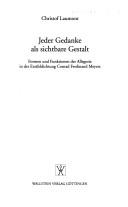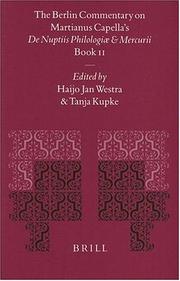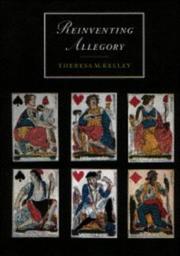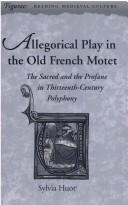| Listing 1 - 10 of 12 | << page >> |
Sort by
|

ISBN: 3892442487 9783892442486 Year: 1997 Publisher: Göttingen : Wallstein,
Abstract | Keywords | Export | Availability | Bookmark
 Loading...
Loading...Choose an application
- Reference Manager
- EndNote
- RefWorks (Direct export to RefWorks)
Book
Year: 1997 Publisher: Rijksbureau voor Kunsthistorische Documentatie
Abstract | Keywords | Export | Availability | Bookmark
 Loading...
Loading...Choose an application
- Reference Manager
- EndNote
- RefWorks (Direct export to RefWorks)
Iconography --- Painting --- allegory [artistic device] --- Ketel, Cornelis --- Floris, Frans I

ISBN: 9789004450325 9789004109681 Year: 1997 Publisher: Leiden;Boston Brill
Abstract | Keywords | Export | Availability | Bookmark
 Loading...
Loading...Choose an application
- Reference Manager
- EndNote
- RefWorks (Direct export to RefWorks)
Completing Prof. Westra's 1994 edition of Book I (published by Brill as Mittellateinische Studien und Texte, 20 ), this critical edition presents the only complete, late medieval Latin commentary on Book II of Martianus Capella's influential handbook of the Seven Liberal Arts. It also provides an Index of Proper Names to both Book I and II. Using his allegorical interpretation of the programmatic marriage of Mercury (eloquence) and Philology (learning) as a speculative, proto-scientific method of enquiry, the commentator provides encyclopedic coverage of medieval philosophy, theology, science, myth, language, literature and education. Intellectually the author is still connected with early scholasticism and the School of Chartres, being more sympathetic to Neoplatonism than to the newly arrived Aristotelians. The present edition has been keyed to Dick's as well as Willis' edition of Martianus Capella.
Book

ISBN: 3932353064 Year: 1997 Publisher: Eurasburg Ed. Minerva
Abstract | Keywords | Export | Availability | Bookmark
 Loading...
Loading...Choose an application
- Reference Manager
- EndNote
- RefWorks (Direct export to RefWorks)
Allegories --- Hercules (Roman mythology) --- Allegory (Art) --- Exempla --- Fiction --- Homiletical illustrations --- Tales --- Fables --- Parables --- Art --- Hercules Farnese --- Hercules [Mythological character]

ISBN: 0521432073 Year: 1997 Volume: 22 Publisher: Cambridge New York Melbourne Cambridge University Press
Abstract | Keywords | Export | Availability | Bookmark
 Loading...
Loading...Choose an application
- Reference Manager
- EndNote
- RefWorks (Direct export to RefWorks)
Allegorie --- Allegory --- Allégorie --- 82.085.41 --- Literature --- -Belles-lettres --- Western literature (Western countries) --- World literature --- Philology --- Authors --- Authorship --- Personification in literature --- Symbolism in literature --- Literaire metafoor. Beeldspraak --- History and criticism --- Allegory. --- History and criticism. --- 82.085.41 Literaire metafoor. Beeldspraak --- -Literaire metafoor. Beeldspraak --- -82.085.41 Literaire metafoor. Beeldspraak --- Belles-lettres --- Appraisal of books --- Books --- Evaluation of literature --- Criticism --- Literary style --- Appraisal --- Evaluation
Multi
ISBN: 9056620762 Year: 1997 Publisher: Rotterdam NAi
Abstract | Keywords | Export | Availability | Bookmark
 Loading...
Loading...Choose an application
- Reference Manager
- EndNote
- RefWorks (Direct export to RefWorks)
Sculpture --- Architecture --- anno 1800-1999 --- Netherlands --- Allegories --- Decoration and ornament, Architectural --- Catalogs. --- History --- Catalogs --- Architectural decoration and ornament --- Stonework, Decorative --- Architectural design --- Exterior walls --- Allegory (Art) --- Exempla --- Fiction --- Homiletical illustrations --- Tales --- Fables --- Parables --- History&delete& --- Decoration and ornament
Book
ISBN: 3775707247 Year: 1997
Abstract | Keywords | Export | Availability | Bookmark
 Loading...
Loading...Choose an application
- Reference Manager
- EndNote
- RefWorks (Direct export to RefWorks)
Graphic arts --- Mannerist [Renaissance-Baroque style] --- Art --- allegory [artistic device] --- Heemskerck, van, Maarten --- Goltzius, Hendrick --- Sadeler, Joannes I --- Vos, de, Maarten --- Galle, Philips --- Passe, van de, Crispijn I --- Floris, Frans I --- Staatsgalerie [Stuttgart] --- anno 1500-1599 --- grafiek --- maniërisme --- allegorieën --- iconografie --- 16de eeuw --- Zuidelijke Nederlanden --- Noordelijke Nederlanden --- 76 "16" --- 76.045 --- 769 <43 STUTTGART> --- Allegories --- Mannerism (Art) --- -Prints, Dutch --- Dutch prints --- Allegory (Art) --- Exempla --- Fiction --- Homiletical illustrations --- Tales --- Fables --- Parables --- Grafische kunsten. Grafiek. Prentkunst--17e eeuw. Periode 1600-1699 --- Symbolische voorstellingen: allegorieën; dodendansen in de prentkunst --- Prentenverzamelingen--Duitsland voor 1945 en na 1989--STUTTGART --- 769 <43 STUTTGART> Prentenverzamelingen--Duitsland voor 1945 en na 1989--STUTTGART --- 76.045 Symbolische voorstellingen: allegorieën; dodendansen in de prentkunst --- 76 "16" Grafische kunsten. Grafiek. Prentkunst--17e eeuw. Periode 1600-1699 --- prints [visual works] --- Prints, Dutch --- Staatsgalerie --- allegorie (symboliek) --- 16de eeuw. --- Zuidelijke Nederlanden. --- Noordelijke Nederlanden.

ISBN: 0804727171 9780804727174 Year: 1997 Volume: *11 Publisher: Stanford (Calif.): Stanford university press,
Abstract | Keywords | Export | Availability | Bookmark
 Loading...
Loading...Choose an application
- Reference Manager
- EndNote
- RefWorks (Direct export to RefWorks)
The motet began as a form of sacred vocal music in several parts; a cantus firmus or tenor, drawn from sacred Latin chant, served as a foundation for one or more upper voices. The French motet was a well-established form by the middle of the thirteenth century, as were bilingual motets that combined at least one French and one Latin text among the upper voices. Though some attention is paid to melodic structure and the relationship between text and music, this book focuses on the literary artistry of the texts of French and bilingual motets, notably the special feature of motets that distinguished them from other medieval lyric forms: the phenomenon of polytextuality. The author analyzes both the interaction of the texts within a motet (when there is more than one texted voice) and the relationship between the texted voice(s) and the tenor. Although some French motets employ vernacular refrains as tenors, the vast majority use Latin tenors, thus maintaining an explicit tie to the liturgical origins of the genre. This presence of sacred and profane elements within a single motet presents an interpretive dilemma that the author suggests can be resolved through an allegorical or parodic reading; indeed, she argues that the tension between allegory and parody is an essential feature of the French motet. The book examines the creative juxtaposition of sacred tenors and vernacular lyric motifs, and the resulting interplay of allegorical and parodic meanings, focusing in particular on the female persona as object of desire and as desiring subject, and on the motives of the separation and reunion of lovers. The author's analysis also discusses the links between the French motet and the secular lyric, the allegorization of love poetry in sermons and mystical texts, sacred parody, and the playful use of liturgical and biblical citations in erotic poetry.
Allegorie --- Allegory --- Allégorie --- Music and language --- Music and literature --- Musique et langage --- Musique et littérature --- Muziek en literatuur --- Muziek en taal --- Motet --- Part songs, French --- Part songs, Latin --- Music and literature. --- Music and language. --- Polyphonies françaises --- Polyphonies latines --- History and criticism --- Histoire et critique --- Motets --- Allegory. --- History and criticism. --- Polyphonies françaises --- Musique et littérature --- Allégorie --- Latin part songs --- French part songs --- Part-songs, Old French --- Literature and music --- Literature --- Language and music --- Language and languages --- Choruses --- Part songs --- Part songs, Sacred --- Personification in literature --- Symbolism in literature --- France --- 500-1400 --- Part-songs [French ] --- Part-songs [Latin ] --- Motets - France - 500-1400 - History and criticism --- Part songs, French - 500-1400 - History and criticism --- Part songs, Latin - 500-1400 - History and criticism
Book
ISBN: 3447037482 Year: 1997 Volume: 75 Publisher: Wiesbaden Harrassowitz
Abstract | Keywords | Export | Availability | Bookmark
 Loading...
Loading...Choose an application
- Reference Manager
- EndNote
- RefWorks (Direct export to RefWorks)
Book history --- Europe --- 7.046.1 --- 7.045 --- Allegory --- -Mythology, Classical, in literature --- -Personification in literature --- Symbolism in literature --- Iconografie: klassieke mythologie --- Iconografie: allegorieen; symbolen; dodendansen; emblemata --- Congresses --- Mythology, Classical, in literature --- Congresses. --- -Iconografie: klassieke mythologie --- 7.045 Iconografie: allegorieen; symbolen; dodendansen; emblemata --- 7.046.1 Iconografie: klassieke mythologie --- mythology [literary genre] --- allegories [document genre] --- -7.045 Iconografie: allegorieen; symbolen; dodendansen; emblemata --- Personification in literature --- Mythology [Classical ] in literature --- Mythology [Classical ] in art --- European literature --- Classical influences --- allegories [literary works]
Book
ISBN: 884355882X Year: 1997 Volume: 2 Publisher: Milano : Electa,
Abstract | Keywords | Export | Availability | Bookmark
 Loading...
Loading...Choose an application
- Reference Manager
- EndNote
- RefWorks (Direct export to RefWorks)
Social classes --- Social classes in art --- Social status --- Art, Roman --- Art, Etruscan --- Classes sociales --- Classes sociales dans l'art --- Statut social --- Art romain --- Art étrusque --- Social aspects --- Aspect social --- Rome --- History --- Historiography --- Histoire --- Historiographie --- Art, Italic --- -Power (Social sciences) in art --- Symbolism in art --- 704.909375 --- Allegory (Art) --- Signs and symbols in art --- Art --- Italic art --- Themes, motives --- Arts Iconography Ancient world Etruria --- Symbolism in art. --- Art étrusque --- Power (Social Sciences) in art
| Listing 1 - 10 of 12 | << page >> |
Sort by
|

 Search
Search Feedback
Feedback About UniCat
About UniCat  Help
Help News
News